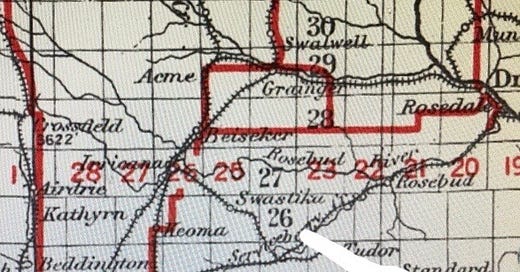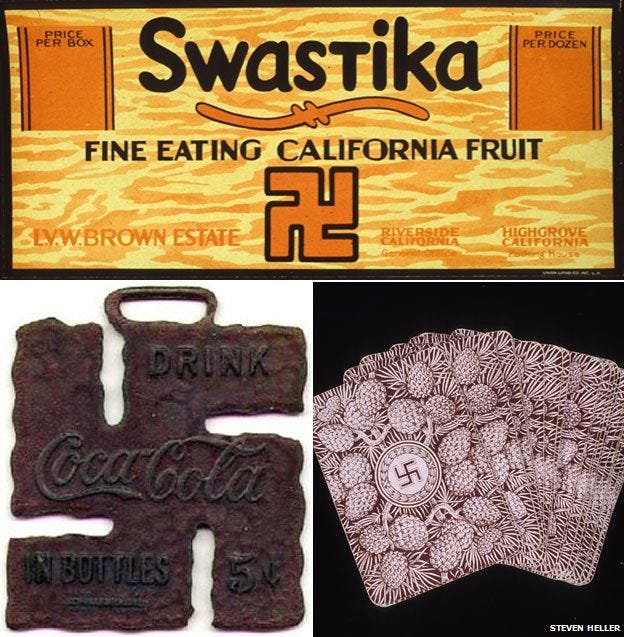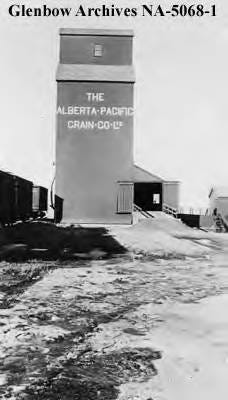Swastika, Alberta: The Town In Need of a Rebrand
The small prairie settlement was located on the C. P. R.’s Nightingale line.
This blog features a little town that doesn’t exist anymore that was called Swastika, Alberta. No, I am not making this up, and it’s located just a few miles away from Pioneer Acres Museum.
At the turn of the twentieth century, immigrants from Germany were very desirable for the Canadian government because they were typically experienced farmers and almost always Protestants. Many of the newcomers settled in the Kathryn, Irricana and Keoma area, and it makes sense that place names would reflect this. In central Alberta we see names like Linden, Beiseker and Stettler. German is the second most spoken language in Alberta, so christening a place Swastika for a symbol from home makes sense.
But the swastika has a richer heritage than that. The equilateral cross has arms bent at right angles, all in the same direction, usually clockwise, and it was a symbol of prosperity and good fortune that was used widely around the world. It has been found inscribed on 15,000-year-old artifacts and has been used as an icon in Hinduism, Buddhism, and Jainism, as a stylized cross in Christianity and in Asiatic cultures as a pattern in art. It appears in Greece on currency, in Medieval, Renaissance, and Baroque architecture, and on artifacts from the Iron Age.
In the early twentieth century the swastika was a popular symbol, and not only in Germany. The Boy Scouts adopted it and the Girls' Club of America called their magazine Swastika. Advertisers liked it too – it was used by fruit companies, on playing cards and even by Coca-Cola, all in North America.
In 1920 the swastika was fated to become forever political when Adolf Hitler adopted it as a symbol of ethnic purity. The ancient emblem of well being now stood for the racial superiority of Nordic and German races over lesser humans such as Celts, Asians, or Jews. (It should be noted that the use of this icon is now outlawed in Germany).
Swastika, Alberta was christened early in the twentieth century for reasons that now hopefully make more sense to you. Local families included the Ludwigs, Snydmillers, Silbernagels and Weisses. The small prairie settlement was located on the C. P. R.’s Nightingale line and in addition to the railroad depot, it also had a grain elevator, a section house and a few other buildings, including a school (the Brushy Lake School) located just to the north.
Like many small towns, Swastika, tactfully rechristened Gayford, doesn’t exist anymore. The school closed in 1950. The elevator was used to store grain until it burned to the ground in 1970 but it had been closed thirty years before that.
Thanks to reader Rhys Courtman who said, “It's interesting that Swastika was renamed Gayford in 1938, around Anschluss and the Munich Agreement, but before the Second World War when the worst of Nazi atrocities became more widely known.”
How did people at the time feel about the rebrand? Sarah Rau weighed in with some of her thoughts in Beiseker’s Golden Heritage, published in 1972. It would be interesting to chat with Sarah today to see if she still agrees with herself; I’m stating this as a person who has changed my own mind a time or two in my life.
There is a lot to think about when we look at our history. I have heard from people who have lived in the Irricana region for forty years and had never heard of Swastika, Alberta. I also heard this comment and loved it, "And people say there is no history in western Canada!"
Thank you to historian, Shelly McElroy, for researching and writing this story about some of our local history.








